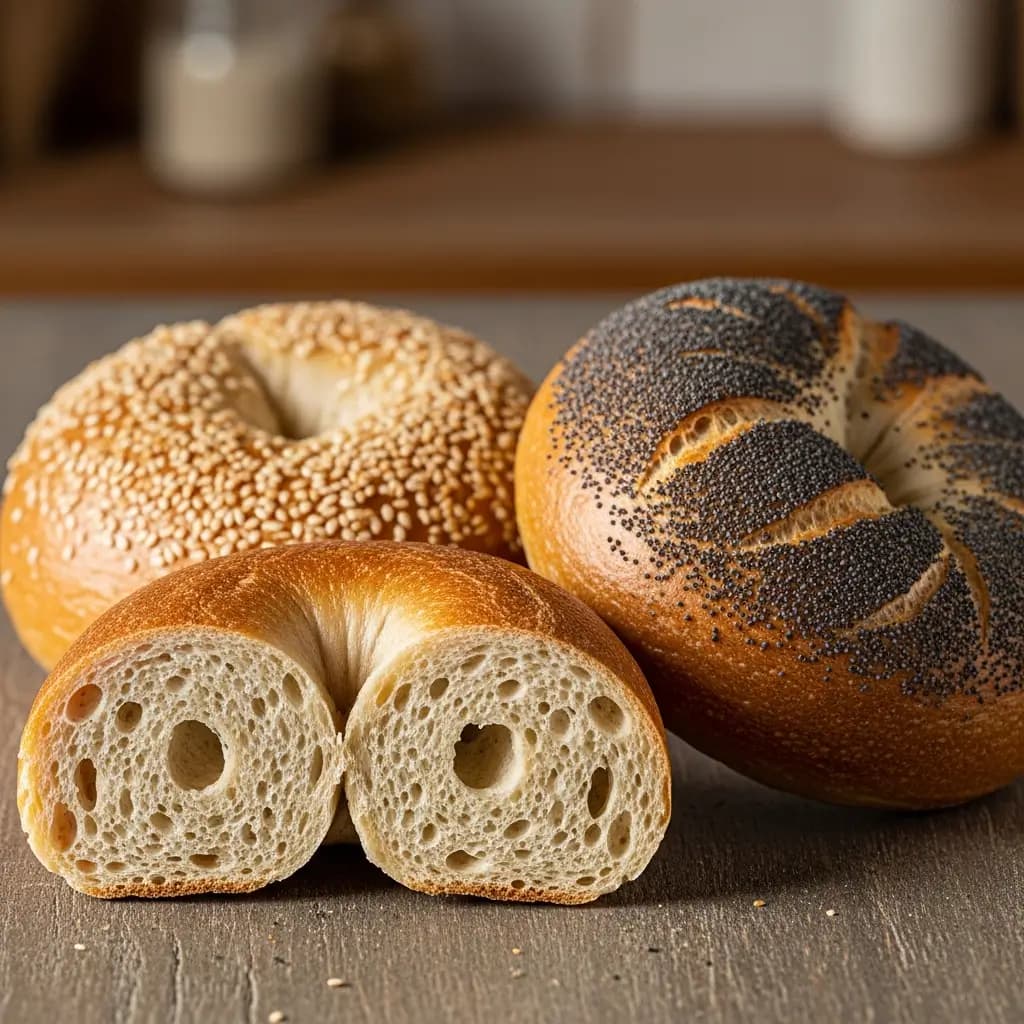The Best Sourdough Pizza Crust Recipe
Updated on November 3, 2025
This post may contain affiliate links.
Jump to a Section:
If you’re looking for the ultimate sourdough pizza crust recipe, you’ve just found it. This dough creates a crust with a crispy, blistered exterior, a chewy yet tender interior with those coveted air pockets, and a subtle tangy flavor that elevates every topping. Whether you’re using active starter or sourdough discard, this recipe is flexible, forgiving, and produces pizzeria-quality results right in your home oven.
The best part? While the dough requires some planning ahead, the hands-on time is minimal. Most of the work happens while you sleep, and you’ll be rewarded with the most delicious homemade pizza you’ve ever tasted.
Why Sourdough Makes the Best Pizza Crust
There’s a reason artisan pizzerias around the world use naturally leavened dough. Here’s what makes sourdough pizza crust superior:
-
- Unbeatable Flavor Complexity: The long, slow fermentation develops deep, nuanced flavors that you simply can’t achieve with commercial yeast. That characteristic tang perfectly complements both sweet and savory toppings.
-
- Superior Digestibility: The fermentation process breaks down gluten and phytic acid, making sourdough pizza easier to digest than conventional pizza. Many people who struggle with regular pizza find sourdough much gentler on their stomachs.
-
- Perfect Texture & Structure: Sourdough creates an open, airy crumb with those beautiful irregular holes, while maintaining enough structure to hold toppings. The crust gets incredibly crispy on the outside while staying tender inside.
-
- Flexibility & Forgiveness: Unlike finicky commercial yeast dough, sourdough is incredibly forgiving. You can extend the fermentation time without ruining the dough, making it perfect for busy schedules.
- Versatile for Active Starter or Discard: This recipe works beautifully with either fed, active starter or unfed discard, making it a practical way to reduce waste.
Ingredients for Sourdough Pizza Dough
For the Pizza Dough:
-
- Active Sourdough Starter or Discard (200g / 1 cup): The heart of the recipe. Fed starter gives more rise; discard works perfectly with slightly longer fermentation.
- Warm Water (300g / 1¼ cups): Use filtered water at room temperature for best results.
- All-Purpose Flour or Bread Flour (500g / 4 cups): Bread flour creates chewier crust; all-purpose works beautifully for a tender result.
-
- Salt (10g / 2 teaspoons): Essential for flavor development and gluten strength.
-
- Olive Oil (2 tablespoons): Adds richness, helps with browning, and makes the dough easier to work with.
-
- Honey or Sugar (1 tablespoon, optional): Feeds the starter and promotes browning.
For Baking:
-
- Semolina or Cornmeal: For dusting the pizza peel and preventing sticking
- Extra Olive Oil: For brushing the crust edges

The Best Sourdough Pizza Crust Recipe
Equipment
- Large mixing bowl ,Wooden spoon or dough scraper ,Plastic wrap or damp towel, Pizza stone or steel, Pizza peel (or parchment paper) .Bench scraper (optional) ,Airtight containers for cold fermentation
Ingredients
Instructions
- 1
Evening, Day 1: Combine sourdough starter and warm water in a large bowl. Add flour, salt, olive oil, and honey. Mix until no dry flour remains. Cover and let rest 30 minutes.
- 2
Perform stretch and folds: wet hands, stretch one side of dough up and fold over. Rotate bowl, repeat 3 more times. Rest 30 minutes. Repeat 2-3 more times.
- 3
Cover tightly and let ferment at room temperature overnight (8-12 hours) until dough is puffy and shows bubbles.
- 4
Morning, Day 2: Turn dough onto floured surface. Divide into 2-3 equal portions. Shape each into a smooth ball.
- 5
Place dough balls in lightly oiled containers. Cover and refrigerate for 4 hours to 3 days.
- 6
Before Baking: Remove dough from fridge 45-60 minutes before baking. Preheat oven with pizza stone to maximum temperature (500-550°F) for 45 minutes.
- 7
Dust work surface with flour or semolina. Press dough ball flat with fingertips, working from center outward. Stretch gently over your knuckles to desired size.
- 8
Transfer to semolina-dusted pizza peel. Add sauce, cheese, and toppings quickly.
- 9
Slide pizza onto preheated stone. Bake 8-12 minutes until crust is golden with dark spots and cheese is bubbly.
- 10
Brush crust edges with olive oil immediately after removing from oven. Let cool 2 minutes, slice, and serve.
Notes
Pro Tips for Perfect Pizza Every Time
Use a Pizza Stone or Steel: This is the single most important tool for achieving crispy, restaurant-quality crust at home. It retains and radiates heat more effectively than a baking sheet, creating that characteristic leopard spotting on the bottom.
Less is More with Toppings: The number one mistake home pizza makers make is overloading their pizza. Keep sauce thin, cheese moderate, and toppings sparse. Too much weight prevents proper crisping and makes the pizza soggy.
Master the Dough Temperature: Cold dough is impossible to stretch; room temperature dough is too elastic. The sweet spot is when the dough ball feels slightly cool but pliable—about 60-65°F. This takes 45-60 minutes out of the fridge.
Extend Fermentation for Better Flavor: If you have time, let the dough cold-ferment for 2-3 days in the refrigerator. The flavor becomes more complex and developed with each passing day.
The Parchment Paper Trick: If you don’t have a pizza peel, shape your pizza directly on parchment paper, then slide the entire sheet (paper and all) onto your preheated stone. Remove the paper halfway through baking for extra crispiness.
Check Your Starter Activity: For the best rise and texture, use starter that’s fed and active (doubled in size). If using discard, add ½ teaspoon of commercial yeast to guarantee good rise, or simply extend your bulk fermentation time.
How to Make Sourdough Pizza Crust (Step-by-Step)

Step 1: Mix Your Dough (Evening, Day 1)
In a large mixing bowl, combine the sourdough starter and warm water. Stir until the starter is mostly dissolved and the mixture looks milky. Add the flour, salt, and olive oil. Stir with a wooden spoon or your hands until no dry flour remains. The dough will be shaggy and sticky—this is exactly what you want. Cover the bowl with a damp towel or plastic wrap.
Step 2: Stretch and Fold (Evening, Day 1)
After 30 minutes, perform the first stretch and fold: wet your hands, grab one side of the dough, stretch it up, and fold it over to the opposite side. Rotate the bowl 90 degrees and repeat. Do this 4 times total (one full rotation). This builds gluten structure without traditional kneading. Repeat this process 2-3 more times at 30-minute intervals.
Step 3: Bulk Fermentation (Overnight)
After your final stretch and fold, cover the bowl tightly and let it ferment at room temperature overnight (8-12 hours). The dough should increase in size by about 50% and show bubbles on the surface. Don’t expect it to double—sourdough pizza dough doesn’t rise as dramatically as bread dough.
Step 4: Divide and Shape (Morning, Day 2)
Turn the dough onto a lightly floured surface. Divide it into 2-3 equal portions (depending on your preferred pizza size—2 portions for larger pizzas, 3 for personal-sized). Shape each portion into a smooth ball by folding the edges toward the center, then flip and use your hands to create tension on the surface.
Step 5: Cold Fermentation (Day 2)
Place each dough ball in a lightly oiled container or on a parchment-lined tray. Cover tightly with plastic wrap and refrigerate for at least 4 hours, or up to 3 days. This cold fermentation is the secret—it develops incredible flavor and makes the dough much easier to stretch without springing back.
Step 6: Bring to Room Temperature (Before Baking)
Remove dough from the refrigerator 45-60 minutes before you plan to bake. This allows it to relax and become more pliable. Meanwhile, place a pizza stone or steel on your oven’s middle rack and preheat to the highest temperature (usually 500-550°F / 260-290°C) for at least 45 minutes.
Step 7: Shape Your Pizza
Generously dust your work surface and dough ball with flour or semolina. Press the dough down with your fingertips, working from the center outward, leaving a slightly thicker border for the crust. Pick up the dough and gently stretch it by draping it over your knuckles, rotating as you go. Don’t use a rolling pin—this deflates those beautiful air bubbles. The dough should be thin in the center with a puffy edge.
Step 8: Top and Bake
Transfer the shaped dough to a semolina-dusted pizza peel or parchment paper. Work quickly now—add your sauce, cheese, and toppings, keeping them relatively light (overloaded pizza won’t crisp properly). Slide the pizza onto your preheated stone or steel. Bake for 8-12 minutes, until the crust is golden brown with dark spots and the cheese is bubbly. Brush the crust edges with olive oil immediately after removing from the oven for extra flavor and shine.



